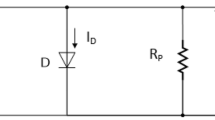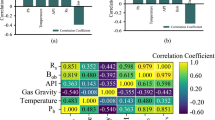Abstract
Proton exchange membrane fuel cell (PEMFC) with low emission is considered as a promising vehicular industry. To achieve higher performance, modelling of the whole PEMFC system is an essential step in designing the most efficient system. In this study, the adaptive neuro-fuzzy inference system (ANFIS) is employed to model the 250-W PEMFC which is located in an electric bicycle. The temperature, humidity, current, hydrogen and oxygen flowrate were used as the inputs and voltage and efficiency employed as the outputs. The analyses of results determine that ANFIS is an accurate and reliable technique for predicting the PEMFC performance.









Similar content being viewed by others
References
Akbari E et al (2016a) Sensor application in direct methanol fuel cells (DMFCs). Renew Sustain Energy Rev 60:1125–1139
Akbari E et al (2016b) ANFIS modeling for bacteria detection based on GNR biosensor. J Chem Technol Biotechnol 91(6):1728–1736
Akbari E et al (2018) Soft computing techniques in prediction gas sensor based 2D material. Org Electron 62:181–188
Azmy AM, Erlich I (2005) Online optimal management of PEMFuel cells using neural networks. IEEE Trans Power Deliv 20(2):1051–1058
Ball M, Wietschel M, Rentz O (2007) Integration of a hydrogen economy into the German energy system: an optimising modelling approach. Int J Hydrogen Energy 32(10–11):1355–1368
Baschuk JJ, Li X (2005) A general formulation for a mathematical PEM fuel cell model. J Power Sources 142(1–2):134–153
Bhagavatula YS, Bhagavatula MT, Dhathathreyan KS (2012) Application of artificial neural network in performance prediction of PEM fuel cell. Int J Energy Res 36(13):1215–1225
Boscaino V, Miceli R, Capponi G (2013) MATLAB-based simulator of a 5 kW fuel cell for power electronics design. Int J Hydrogen Energy 38(19):7924–7934
Brandon C, Hommann K (1996) The cost of inaction: valuing the economy-wide cost of environmental degradation in India. UNU, Institute of Advanced Studies, Kanagawa
Contreras A, Posso F, Guervos E (2010) Modelling and simulation of the utilization of a PEM fuel cell in the rural sector of Venezuela. Appl Energy 87(4):1376–1385
Faiz A, Weaver CS, Walsh MP (1996) Air pollution from motor vehicles: standards and technologies for controlling emissions. The World Bank, Washington
Gong W, Cai Z (2014) Parameter optimization of PEMFC model with improved multi-strategy adaptive differential evolution. Eng Appl Artif Intell 27:28–40
Ismail MS et al (2014) An efficient mathematical model for air-breathing PEM fuel cells. Appl Energy 135:490–503
Jang J-S (1993) ANFIS: adaptive-network-based fuzzy inference system. IEEE Trans Syst Man Cybern 23(3):665–685
Jang JS (1996) Input selection for ANFIS learning. In: Proceedings of IEEE 5th international fuzzy systems. IEEE
Jang J-Y et al (2012) Experimental and numerical study of proton exchange membrane fuel cell with spiral flow channels. Appl Energy 99:67–79
Jemeı S et al (2003) On-board fuel cell power supply modeling on the basis of neural network methodology. J Power Sources 124(2):479–486
JemeÏJemei S et al (2008) A new modeling approach of embedded fuel-cell power generators based on artificial neural network. IEEE Trans Ind Electron 55(1):437–447
Kheirandish A, Kazemi MS, Dahari M (2014) Dynamic performance assessment of the efficiency of fuel cell-powered bicycle: an experimental approach. Int J Hydrogen Energy 39(25):13276–13284
Kheirandish A et al (2016a) Dynamic modelling of PEM fuel cell of power electric bicycle system. Int J Hydrogen Energy 41(22):9585–9594
Kheirandish A et al (2016b) Modeling of commercial proton exchange membrane fuel cell using support vector machine. Int J Hydrogen Energy 41(26):11351–11358
Kreinovich V, Quintana C, Reznik L (1992) Gaussian membership functions are most adequate in representing uncertainty in measurements. In: Proceedings of NAFIPS 1992
Lee W-Y et al (2004) Empirical modeling of polymer electrolyte membrane fuel cell performance using artificial neural networks. Int J Hydrogen Energy 29(9):961–966
Napoli G et al (2013) Data driven models for a PEM fuel cell stack performance prediction. Int J Hydrogen Energy 38(26):11628–11638
Nilashi M et al (2015) A multi-criteria collaborative filtering recommender system for the tourism domain using Expectation Maximization (EM) and PCA–ANFIS. Electron Commer Res Appl 14(6):542–562
Nilashi M et al (2017) A soft computing method for the prediction of energy performance of residential buildings. Measurement 109:268–280
Ogaji SOT et al (2006) Modelling fuel cell performance using artificial intelligence. J Power Sources 154(1):192–197
Ou S, Achenie LEK (2005) A hybrid neural network model for PEM fuel cells. J Power Sources 140(2):319–330
Özbek M et al (2013) Modeling and control of a PEM fuel cell system: a practical study based on experimental defined component behavior. J Process Control 23(3):282–293
Reddy CS, Raju K (2009) An improved fuzzy approach for COCOMO’s effort estimation using gaussian membership function. J Softw 4(5):452–459
Rezazadeh S et al (2012) Using adaptive neuro-fuzzy inference system (ANFIS) for proton exchange membrane fuel cell (PEMFC) performance modeling. J Mech Sci Technol 26(11):3701–3709
Rowe A, Li X (2001) Mathematical modeling of proton exchange membrane fuel cells. J Power Sources 102(1–2):82–96
Silva RE et al (2014) Proton exchange membrane fuel cell degradation prediction based on adaptive neuro-fuzzy inference systems. Int J Hydrogen Energy 39(21):11128–11144
Sisworahardjo NS et al (2010) Neural network model of 100 W portable PEM fuel cell and experimental verification. Int J Hydrogen Energy 35(17):9104–9109
Tiss F, Chouikh R, Guizani A (2013) Dynamic modeling of a PEM fuel cell with temperature effects. Int J Hydrogen Energy 38(20):8532–8541
Vural Y, Ingham DB, Pourkashanian M (2009) Performance prediction of a proton exchange membrane fuel cell using the ANFIS model. Int J Hydrogen Energy 34(22):9181–9187
Yu S, Jung D (2010) A study of operation strategy of cooling module with dynamic fuel cell system model for transportation application. Renew Energy 35(11):2525–2532
Acknowledgements
We thank the TDTU for their support.
Author information
Authors and Affiliations
Corresponding author
Ethics declarations
Conflict of interest
The author(s) declare that there is no conflict of interest regarding the publication of this article.
Additional information
Editorial responsibility: M. Abbaspour.
Rights and permissions
About this article
Cite this article
Kheirandish, A., Akbari, E., Nilashi, M. et al. Using ANFIS technique for PEM fuel cell electric bicycle prediction model. Int. J. Environ. Sci. Technol. 16, 7319–7326 (2019). https://doi.org/10.1007/s13762-019-02392-6
Received:
Revised:
Accepted:
Published:
Issue Date:
DOI: https://doi.org/10.1007/s13762-019-02392-6




